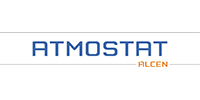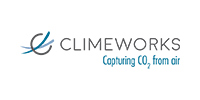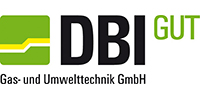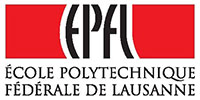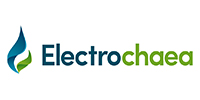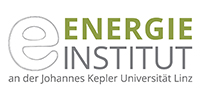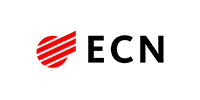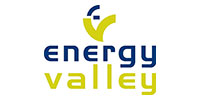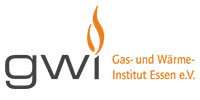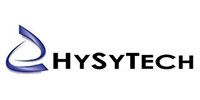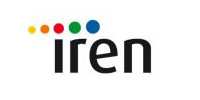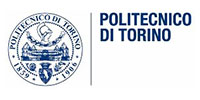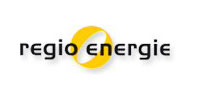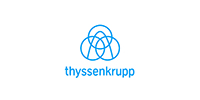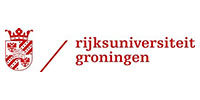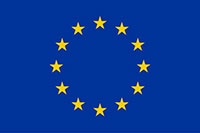Structure of the STORE&GO project
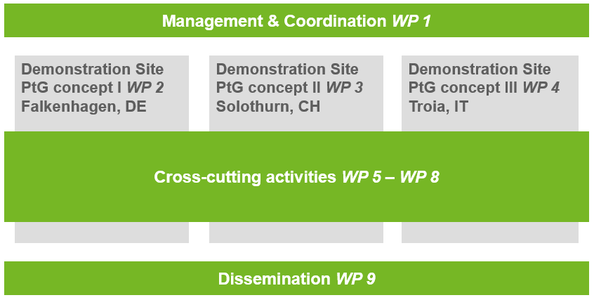
Public Deliverables of the STORE&GO project
Work packages 2, 3 & 4: The three STORE&GO demonstration sites in Germany, Italy and Switzerland
2017-11-30 Deliverable 2.3 Demonstration plant Falkenhagen commissioned / commissioning report
The report includes a process description and gives an overview of the manufacturing process and the applied commissioning procedures. These were implemented after mechanical completion was reached on site, according to the German “Agreement Steam Boilers 0012010-10” (Guideline on the Risk Assessment of Putting into Operation).
2020-02-29 Deliverable 2.7 Final report on dissemination activities for the Falkenhagen plant
This report summarises the dissemination and communication activities that were undertaken by STORE&GO all around the german demonstration plant in Falkenhagen and the achieved results. Target groups of the dissemination actions are described, as well as the hosted on-site events, the guided tours at the facility and the facility-related press communication.
2018-12-31 Deliverbale 3.3 PtG demonstration plant Solothurn commissioned
This reports summarises the commissioning and the different commissioning phases of the Solothurn demonstration plant in Switzerland. Besides a basic description of the plant process, the plant layout and erection, the specific commissioning activities and the supporting contractors and suppliers are described.
2019-12-31 Deliverable 3.7 Dissemination activities around demonstration plant in Solothurn
This report summarises the dissemination and communication activities that were undertaken by STORE&GO all around the swiss demonstration plant in Solothurn and the achieved results. It gives an insight on activities such as the demo site homepage, the demo site patron, the demo site events, guided tours, training programmes or press releases of the demo site. In the annex a comprehensive view of the demo-site publications and press-releases is provided.
2019-12-31 Deliverable 4.12 Final report on dissemination activities for the Troia plant
This report summarises the dissemination and communication activities that were undertaken by STORE&GO all around the italian demonstration plant in Troia and the achieved results. After a definition of the target group, a insight in the dissemination activities is given. These described activities are the demo site patrons, on-site events, guided tours, educational training programmes, demo site media and press communication material. In the annex a list of press publications is given.
Work Package 5: Techno-economic analysis of storage demonstration operation
2020-02-29 Deliverable 5.9 Final report on evaluation of technologies and processes
The report presents the technical as well as the economic evaluation of the three different demo sites. Therefore, the system boundaries are carefully chosen and performance indicators are defined within the project. To test the long term stability and the load flexibility of the demo sites, different test profiles were defined and applied to the demo sites. Generally, all three demo sites reached the defined goal of a methane content of higher than 90 vol.-% at different loads. It was shown that an overall PtG efficiency of higher than 75 % can be achieved. Furthermore, energetic optimizations are discussed within this Deliverable.
2020-02-29 Deliverable 5.10 Report on economic analysis of test cases
This report deals with the economic aspects of SNG injection for different combinations of SNG plants and gas networks, as well as of optimised operation schemes for the gas networks. Next to the demo plants and the connected gas grids from within this project, combinations of several typical test grid topologies and increased plant sizes are considered in this Deliverable, when calculating costs for injecting SNG under different network operation schemes. In addition, the capacities of the gas infrastructure and the connected underground storages for long term storage of currently natural
gas, in the future SNG, are shown.
Work Package 6: Integration of PtG concepts in electricity grid management and power supply
2017-04-29 Deliverable 6.1 Report on opportunities and options for PtG in the power system
This report aims to investigate the role of Power-to-Gas (PtG) in the electrical system, in particular drawing its possible use in the different sectors of the ES (Electricity System). Since one of the partners involved has special expertise in the operation of gas-fired power plants, coupling PtG with such plants was chosen as first application for a deeper investigation. The study includes the technical and legislative aspects involved in the use of Synthetic Natural Gas (SNG) as fuel for gas turbines. An outlook on further applications promising for investigation is provided.
2019-08-01 Deliverable 6.3 Impact Analysis and Scenarios design
This Report evaluates over 120 scenarios based on a parametric variation of 22 parameters that are related either to the system (e.g. CO2 storage) or the technology (e.g. PtM Capex). Out of those 120 scenarios 55 were selected for more detailed analysis. This allowed the researchers to identify the critical parameters to promote PtM deployment and on the other hand the role of the technology. For 21 out of the 55 low carbon scenarios PtM capacity lies in the range of 40 to 200 GW in Europe.
2019-08-01 Deliverable 6.4 Report on the model of the power system with PtG
The Deliverable presents different network models aiming to properly represent both the transmission and distribution grids and tries to answer the impact on the operation of the system of integrating PtG and the impact of PtG on the electricity grid development. In particular, the study regarding the transmission network is organized by considering three network samples. The first network is the European configuration of the CIGRE’ HV Transmission System. The second transmission network considered is the simplified version of the European 400kV system, covering most of continental Europe (17 countries). The third transmission network considered is a simplified EU network, composed of 256 nodes: it represents the results obtained by clustering the EU transmission network (composed of more than 6000 nodes), and uses standard values for the HV lines.
2019-08-01 Deliverable 6.5 Real time implementation of grid models
This Deliverable is focused in particular on how to integrate the information about the facilities replicating the real world condition into a simulation environment. For doing this, the concept of Remote Hardware-in-the-loop (RHIL) has been exploited. Remote simulation with physical hardware appears to be an effective means for investigating new technologies for the energy transition, with the purpose of solving the issues related to the introduction of new Renewable Energy Sources (RES) into the electricity system. These solutions are making the overall energy systems to be investigated much more complex than the traditional ones, introducing new challenges to the research.
2020-08-31 Deliverable 6.6 Report on the impact of PtG on selected scenarios
This Deliverable presents the results obtained by investigating the interaction between the future electricity transmission system and the Power-to-Gas (PtG) technology. In the framework of the project STORE&GO, Work Package 6 (WP6) focused on the modelling and simulation of PtG into the electricity system, with the aim to highlight the contribution that PtG can have on network stabilisation in a long-term perspective. Starting from the models used and presented in D6.4, and taking into account the long-term perspective of the project, this Deliverable aims to investigate the additional flexibility that PtG technology can add to the electricity system in some 2040 scenarios. A summary of the main modeling aspects are reported and the optimal siting and sizing of PtG plants are discussed as well.
2020-02-29 Deliverable 6.7 Final report "PtG grid integration experiments"
This Deliverable focused in particular on how to integrate the information about the facilities replicating the real world condition into a simulation environment. For doing this, the concept of remote Physical Hardware-in-the-Loop (PHIL) has been used and exploited. Remote simulation with physical hardware appears to be an effective means for investigating new technologies for the energy transition, with the purpose of solving the issues related to the introduction of new Renewable Energy Sources (RES) into the electricity system. These solutions are making the overall energy systems to be investigated much more complex than traditional ones, introducing new challenges to research.
Work Package 7: Reducing Barriers
2017-10-31 Deliverable 7.1 Innovative large-scale energy storage technologies and power-to-gas concepts after optimization
To complement the techno-economic evaluation of the Power-to-gas (PtG) technology (private perspective) a broader assessment looking at all the possible impacts on society is also required (social perspective). The assessment of these external effects could lead to a net positive benefit for society that would justify further public funding and support of the technology. For this task, the Social Cost-Benefit Analysis (SCBA) has been chosen given that it takes all possible changes in society welfare into account. This Deliverablefocuses on the environmental component of SCBA and constitutes the link between environmental impact and the monetary valuation needed to weightwith other variables in the SCBA.
2017-10-31 Deliverable 7.2 European Legislative and Regulatory Framework on Power-to-Gas
This Deliverable is part of the work within the STORE&GO project and has as its objective to identify legal and regulatory challenges at the level of the European Union (EU) for the deployment of power-to-gas. Together with Deliverable 7.3,which assesses national legislation applicable to power-to-gas in the countries where the STORE&GO pilot plants are sited (Germany, Switzerland, and Italy), this Deliverable was part of Task 7.3 of the STORE&GO project, which focus is on legal and regulatory barriers. Together, Deliverable 7.2 and 7.3 provide input for the STORE&GO roadmap.
2018-07-04 Deliverable 7.3 Legislative and Regulatory Framework for Power-to-Gas in Germany, Italy and Switzerland Due
This Deliverable has as its goal to identify legal and regulatory challenges for the development of power-to-gas ar the European union (EU) and national level. The focus is on the national legal framework applicable to power-to-gas in Germany, Italy, and Switzerland, the three countries in which the STORE&GO pilot sites were located. Topics which are covered are: legal classification of power-to-gas, unbundling of power-to-gas in relation to system operation and gas storage system operation, national authorisation procedures for the STORE&GO pilot plants, legal measures faciliating the injection of synthetic, or substitute, natural gas (SNG) into the gas network, exemptions from network tariffs and other charges, and national support schemes related to the use of SNG.
2019-08-01 Deliverable 7.4 Full socio-economic costs and benefits of energy mix diversification and the role of power-to-gas in this regard
This deliverable analyses what the contribution of power-to-gas is to energy mix diversity and more broadly to energy security. Can this development be quantified and preferably be valued. The energy security contribution of power-to-gas is analysed for four scenario for Europe until 2050, assuming a CO2 emission reduction of 95 percent. These scenarios are analysed with the JRC-EU-TIMES model, which contains an extensive energy system representation at European scale.
2019-08-01 Deliverable 7.5 Report on experience curves and economies of scale
This deliverable focuses on the analysis of investment cost reduction for power-to-gas applications through experience curves and economies of scale. Economies of scale refers solely to the effect of real cost reductions through an increase of the production volume and not to cost reductions in consequence of an increase in size in form of upscaling. To get a detailed view of technological learning, a component-based approach was developed with the model CoLLeCT- Component Level Learning Curve Tool. This allows for comparisons of learning effects between different technologies, investigation of cost structure developments, and consideration of spill over effects from concurrent technology sectors.
2019-08-01 Deliverable 7.6 Full CBA analysis of power-to-gas in the context of various reference scenarios
The report presents a social cost benefit analysis based on energy system modelling for the European Union until 2050 for various scenarios. Both external effects (security of supply and environmental impacts) and private costs and benefits (energy system costs) are analysed and combined. The report focusses at the following research question: What are social costs and benefits of PtG in the European context under various scenarios. These scenarios are quantitatively analysed with the JRC-EU-TIMES model, which contains an extensive energy system representation for the EU28+ and distinguishes six sectors (power, commercial, industry, residential, transport and agriculture).
2019-08-01 Deliverable 7.7 Analysis on future technology options and on techno-economic optimization
Since the market launch and development of PtG technology depend on, among other things, the profitability (and thus mainly on the investment costs) of the plant, the potential cost reduction are examined in this Deliverable D7.7. In addition to the key technological characteristics (e.g., state of the art and future projects), new developments, technologies and materials, and potential future fields of application are analysed. Finally, the SNG production costs are calculated for different applications in order to demonstrate PtG’s potential. In general, there is little difference in SNG production costs according to the technology used, whereby in future PtG plants with an alkaline electrolyser will have slightly higher SNG production costs than those with a PEM electrolyser, and a PtG plant built with an SOEC and catalytic methanation will tend to have slightly lower SNG production costs.
2019-08-01 Deliverable 7.8 Report on social and public acceptance determinants in selected EU-countries
The main goal of this Deliverable is to investigate factors that determine social acceptance of power-to-gas (PtG) technology in four involved in the STORE&GO project countries, namely Germany, Austria, Italy and Switzerland. In order to reach this goal, a survey of 500 households in each of the four countries was conducted. This survey included a choice experiment examining the preferences of European households with respect to PtG and alternative energy infrastructures. Further on, the survey also collected information on household knowledge and attitude with respect to renewable energy, as well as their current socio-demographic characteristics and their experiences with respect to their electricity provider and consumption issues (power outages, delays in bill payment, etc.).
Work Package 8: Market uptake
2017-08-29 Deliverable 8.1 Exploring the future for green gases
In this report, the various factors determining the greening of gas across the EU by 2030 have been inventoried, and summarised in four scenarios, that differ in the degree to which markets on the one hand and policies and measures on the other hand create incentives to get to green gases. In the two extreme scenarios, either (in the optimistic scenario) the share of green gas would grow towards 13% to 14% even if the ‘greening’ through CO2 certificates would not be included, or (in the pessimistic scenario) the current share of about 4% would hardly grow (some 4.5%), again excluding the greening through CO2 certificates. Obviously, if the ‘greening’ through CO2 certificates is included in the scenarios, the differences mentioned could grow towards much wider proportions.
2019-08-01 Deliverable 8.2 Report on the acceptance and future acceptability of certificate-based green gases
This deliverable analyses the performance of energy certificate markets over time and relates two design features of certification schemes to market performance. More specific, we analyse if the performance of a certificate system depends on (i) the fact if the certifier is a public or private institution and (ii) the adoption of a common international standard. We find that certificate markets are still in their infancies. While increasing shares of renewable electricity are certified, suggesting this trade mechanism is becoming increasingly important, certificate markets still suffer from poor market liquidity and high volatility in prices. Our results imply that private certifiers are associated with lower market volumes while adopting an international standard has a positive effect on certified volumes.
2019-08-01 Deliverable 8.3 Report on the costs involved with PtG technologies and their potentials across the EU
This report presents an overview of current costs of power-to-gas (PtG) plants that produce methane, including investment costs, operational costs and feedstock costs. The costs are estimated based on literature sources and data from the STORE&GO demonstration plants that are currently built in Falkenhagen (Germany), Solothurn (Switzerland) and Troia (Italy). The report first gives an overview of the investment and operational costs for the different PtG plant components: the electrolyser, hydrogen storage, methanation reactor, CO2 storage, compressors, pipelines, gas grid injection, refuelling station and oxygen and heat capture.
2019-08-01 Deliverable 8.5 The short, medium and long term perspectives of various dedicated market segments for ‘green gases’
Is it likely that a breakthrough towards a huge majority part of the EU gases uptake being green will be achieved towards 2050, when greening would need to be nearly completed. This report shows that this will be a formidable challenge that will need to be aggressively pursued by industry and policymakers working together starting as soon as possible, and will need to cover all major three technologies towards producing carbon-neutral gases: gases from biomass; natural gas ‘cleaned’ via CCS or CCU; or renewable gases from electrolysis and methanation with the help of green power. The fourth alternative, greening natural gas with the help of certificates, is considered to remain part of marketing the greening of gas in actual practice, but not as a fundamental source of green gas supply. The detailed country analyses included in this study adds a more disaggregated, context-specific, bottom-up perspective. The bottom-up analysis suggests that many top-down perspectives, could considerably overestimate the realistic speed of electrification, phase out of fossils, implementation of energy saving measures, and thereby underestimate future (renewable) gas demand.
2019-08-01 Deliverable 8.6 Report on the optimal time profile and operation of the conversion technology during a representative year, in the perspective of the available storage capacities
This report gives an overview on economics for various operating strategies of Power-to-Gas methanation plants during a representative year. Four different basic operating strategies considering the electricity and gas market were analysed (1–4). The operating strategies vary in whether or not electricity and gas are bought and sold according to hourly and daily varying price levels or via long-term contracts that are arranged on forehand and therefore ensure continuous operation of the plant (or parts of the plant). Besides the basic operating strategies, the authors see further opportunities for applying PtG in the near future (2030–2050). Therefore, eight additional strategies (5–12) have been analysed. In addition to long-term contracts and trading on the day-ahead market, these strategies consider direct coupling of the PtG plant with a renewable energy source and the seasonal use of surpluses (grid services) on the electricity purchase.
2019-04-30 Deliverable 8.7 Report on data and methods used for the potential analysis of power-to-methane in Europe
This report presents the input data and the methods used for calculating the potential CO2 that can be captured from the relevant industry sectors and biogas plants in Europe for large-scale PtG energy storage as well as the methods for locating the most suitable potential PtG locations. The number of the industry plants within the considered industry sectors, their total emitted CO2 amounts and their geographical distribution are also demonstrated. The potential locations for the PtG energy conversion plants are identified based on the geographical availability of wind energy
and substation distribution, combined with the industrial and biological CO2 sources. In this Deliverable D8.7 of the STORE&GO project, the focus is on the potential of coupling wind energy generation with CO2 sources for the production of renewable gas along the PtG route.
2019-12-31 Deliverable 8.8 The societal business case for power-to-gas: valuing positive and negative externalities
This report shows that power-to-gas (PtG) is a technology that has various positive externalities (including environmental, health, grid cost and balancing and energy security benefits) that provide benefits to other stakeholder groups (like network operators and the broader society) in the market system, but not directly result in a commercially viable business case for PtG investments. We use a four quadrant framework to plot key PtG externalities, and discuss and analyse these externalities in more detail. We assess that to further the development of PtG in the EU, these positive externalities could serve as a rationale for policy change, and could be monetised and redistributed to cover the higher PtG investment costs and risks. We observe that within the current policy regime there is a risk of PtG underinvestment.
2020-02-29 Deliverable 8.9 Report on an EU-wide potential analysis of power-to-gas locations coupled to local CO2 and renewable energy sources
This report's objectives were to identify suitable locations for power-to-methane (PtM) in Europe and to estimate the methane production potential for 2050. The PtM location identification is based on the concept of coupling existing CO2 sources (biogas and industrial plants) with locally available renewable energy (RE) sources, i.e. wind turbines and utility-scale PV systems. The data acquisition was performed by researching publicly available data on renewable energy generation and biogas production sites, as well as by manual research to confirm or extend the available data. For the industrial CO2 emissions, the European Pollutant Release and Transfer database was exploited. The projections of the 2050 methane production potentials were carried out on national level. Since the design of this study centres the development of power-to-methane plants around existing CO2 sources, the production potentials were assessed on the basis of two scenarios for the future availability of CO2: a limited CO2 availability scenario and a balanced CO2 availability scenario, respectively. The resulting power-to-methane maps provide insights into the possibilities of developing a methanation technology rollout starting from the status quo of renewable energy infrastructure in Europe.
2020-02-29 Deliverable 8.10 Roadmap and policy recommendations for power-to-gas in the EU up to 2050
This deliverable's objective was to create a roadmap for large-scale storage based Power-to-Gas conversion in the EU up to 2050. It draws the energy picture of the EU 2050 and shows the technological characteristics and potential technical and economic development of the power-to-gas technologies. In addition, the roadmap shows measures and policy recommendations that are needed for further development of the legislation on power-to-gas and includes a timeline on the proposed temporal deployment of these measures up to 2050.
Work Package 9: Public awareness, dissemination & education
2019-08-01 Deliverable 9.4 Design and development of the 3-day training programme, including online learning programmes, case development and other information bases
This report focuses on the development and design process of the training programme “Power to (the) molecules – from technology to market uptake”, which will be executed in a series of eight editions. The programme exist out of an online and classroom programme, which together will take the participant 3 days. During the online and classroom parts of the training programme different learning methods and materials will be used.
2020-02-29 Deliverable 9.7 Report on the implementation of the various training programmes and their main results in terms of insights, knowledge and experiences
This report summarizes the outcomes of the 3-day training programmes “Power to (the) molecules – from technology to market uptake”, which were executed as part of the dissemination activities of STORE&GO. The general objectives of the trainings are extensively discussed as well as the methodology and activities undertaken to come to the final programme, such as content development, lecturers’ selection, learning methods, material development, marketing and
logistics. Furthermore, an overview of the evaluation of the various training editions, the follow-up plan for future trainings and potential barriers in market adoption are given.
2020-02-29 Deliverable 9.8 Final communication and dissemination report
This final report on the dissemination and communication activities of STORE&GO summarises the activities undertaken by WP 9 and the other partners of the STORE&GO project over the complete project runtime to adequately support this lighthouse project, and to communicate its core messages and results to the relevant stakeholder groups.

